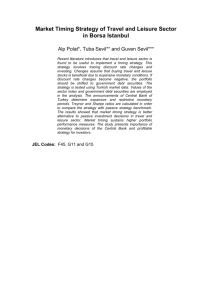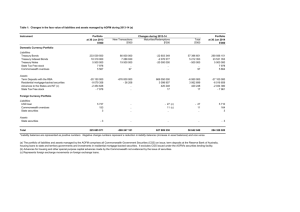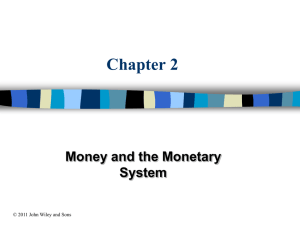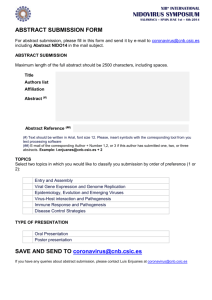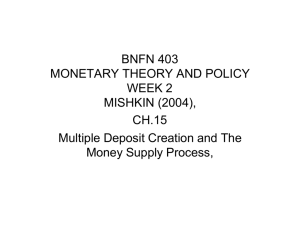Metodický list
advertisement
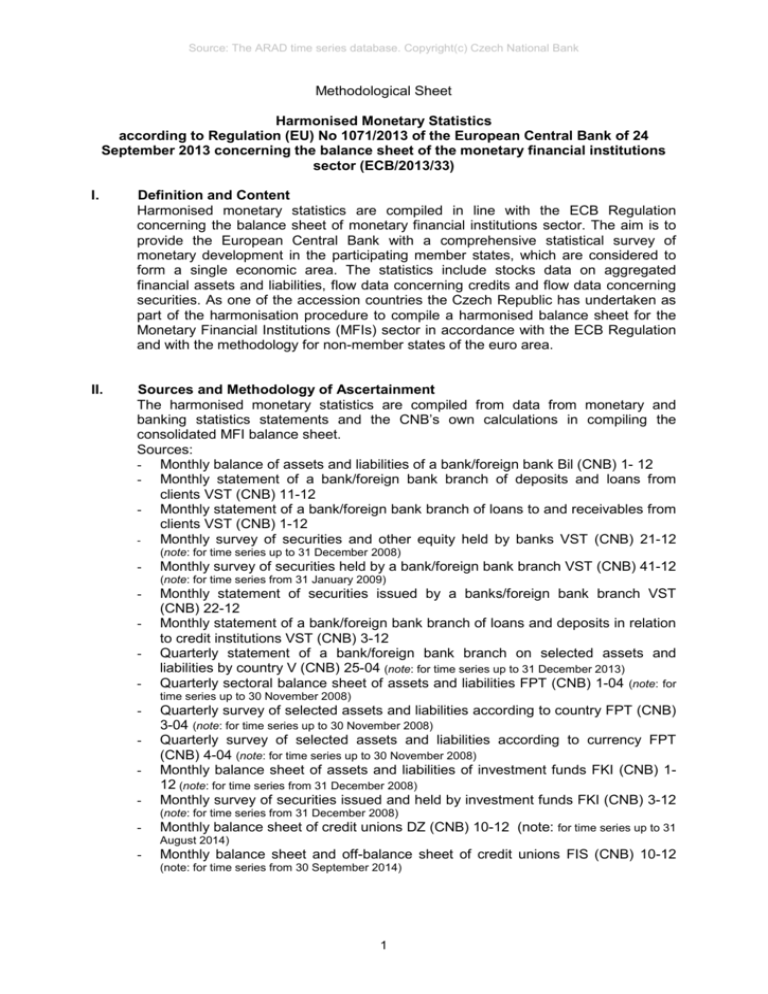
Source: The ARAD time series database. Copyright(c) Czech National Bank Methodological Sheet Harmonised Monetary Statistics according to Regulation (EU) No 1071/2013 of the European Central Bank of 24 September 2013 concerning the balance sheet of the monetary financial institutions sector (ECB/2013/33) I. Definition and Content Harmonised monetary statistics are compiled in line with the ECB Regulation concerning the balance sheet of monetary financial institutions sector. The aim is to provide the European Central Bank with a comprehensive statistical survey of monetary development in the participating member states, which are considered to form a single economic area. The statistics include stocks data on aggregated financial assets and liabilities, flow data concerning credits and flow data concerning securities. As one of the accession countries the Czech Republic has undertaken as part of the harmonisation procedure to compile a harmonised balance sheet for the Monetary Financial Institutions (MFIs) sector in accordance with the ECB Regulation and with the methodology for non-member states of the euro area. II. Sources and Methodology of Ascertainment The harmonised monetary statistics are compiled from data from monetary and banking statistics statements and the CNB’s own calculations in compiling the consolidated MFI balance sheet. Sources: - Monthly balance of assets and liabilities of a bank/foreign bank Bil (CNB) 1- 12 - Monthly statement of a bank/foreign bank branch of deposits and loans from clients VST (CNB) 11-12 - Monthly statement of a bank/foreign bank branch of loans to and receivables from clients VST (CNB) 1-12 Monthly survey of securities and other equity held by banks VST (CNB) 21-12 (note: for time series up to 31 December 2008) - Monthly survey of securities held by a bank/foreign bank branch VST (CNB) 41-12 - Monthly statement of securities issued by a banks/foreign bank branch VST (CNB) 22-12 Monthly statement of a bank/foreign bank branch of loans and deposits in relation to credit institutions VST (CNB) 3-12 Quarterly statement of a bank/foreign bank branch on selected assets and liabilities by country V (CNB) 25-04 (note: for time series up to 31 December 2013) Quarterly sectoral balance sheet of assets and liabilities FPT (CNB) 1-04 (note: for (note: for time series from 31 January 2009) - time series up to 30 November 2008) - Quarterly survey of selected assets and liabilities according to country FPT (CNB) 3-04 (note: for time series up to 30 November 2008) Quarterly survey of selected assets and liabilities according to currency FPT (CNB) 4-04 (note: for time series up to 30 November 2008) Monthly balance sheet of assets and liabilities of investment funds FKI (CNB) 112 (note: for time series from 31 December 2008) Monthly survey of securities issued and held by investment funds FKI (CNB) 3-12 - Monthly balance sheet of credit unions DZ (CNB) 10-12 (note: for time series up to 31 - Monthly balance sheet and off-balance sheet of credit unions FIS (CNB) 10-12 - (note: for time series from 31 December 2008) August 2014) (note: for time series from 30 September 2014) 1 Source: The ARAD time series database. Copyright(c) Czech National Bank III. Break - down a) Instrument and maturity categories Liabilities Currency in circulation Deposits (including non-negotiable securities) Overnight Redeemable at notice up to 3 months inclusive Redeemable at notice over 3 months With agreed maturity up to 2 years inclusive With agreed maturity over 2 years Repurchase agreements Debt securities issued Debt securities issued up to 1 year inclusive Debt securities issued from 1 to 2 years inclusive Debt securities issued over 2 years Money market funds shares/units Money market paper (to the end of 2002) Capital and reserves Remaining liabilities Assets Cash Loans (including non-negotiable securities) up to 1 year inclusive Loans (including non-negotiable securities) from 1 to 5 years inclusive Loans (including non-negotiable securities) over 5 years Securities other than shares up to 1 year Securities other than shares from 1 to 2 years Securities other than shares over 2 years Money market paper (to end of 2002) Money market funds shares/units Shares and other equity Fixed assets Remaining assets b) Currencies CZK EUR Other currencies It must be possible to compile monetary aggregates so that they include balances expressed in CZK, EUR and other foreign currencies. Balances in the national currency and EUR are reported separately for those balance sheet items that are incorporated in monetary aggregates. c) Counterparts (sectors, countries) The compilation of monetary aggregates and their counter-items requires the identification of counterparts that are found both at home and in the participating member states and which comprise the money holding sector. Counterparts at home or in participating member states are identified according to the domestic sector that most closely corresponds to ESA 2010 (European System of Accounts) and in accordance with the list of monetary financial institutions for statistical purposes. In order to be able to classify the money holding sector, counterparts other than MFIs are broken down into government institutions (S.13), where central government institutions (S.1311) are monitored separately in total deposits liabilities, and into other residents. In order to be able to calculate the sector classification of monetary aggregates and credit counterparts, other residents are divided into non-financial corporations (S.11), other financial intermediaries, financial auxiliaries and captive financial institutions and money 2 Source: The ARAD time series database. Copyright(c) Czech National Bank lenders (S.124+S.125+S.126+S.127), insurance corporations and pension funds (S.128+S.129), households and non-profit institutions serving households (S.14+S.15). d) Purpose of credits Credits granted to households are broken down according to the type of credit into consumer credits, lending for house purchase and others. e) Industrial classification of loans provided to non-financial corporations (divisions according to CZ-NACE rev.2): Agriculture, forestry, fishing (01, 02, 03) Industry (05-33, 35-39) Construction (41, 42, 43) Wholesale and retail trade, repair, hotels and restaurants (45, 46, 47, 55, 56) Transport, communications (49, 50, 51, 52, 53) Business services (58-63, 68-75, 77-82) Other services (84-88, 90-99) IV. Method of calculation The CNB compiles: its own central bank balance sheet, the aggregated balance sheet of other MFIs (a simple aggregate of the balance sheets of individual commercial banks, money market funds and credit unions) the consolidated balance sheet of monetary financial institutions in the Czech Republic, which serves as the basis for the calculation of monetary aggregates and their counterparts. This is compiled as the sum of the central bank’s balance sheet and the aggregated balance sheet of monetary financial institutions: 1) excluding mutual inter-bank relations in the sphere of credits and deposits, including non-negotiable securities, 2) with issued money in circulation less cash at commercial banks’ counters and 3) MFI liabilities from the issue of other debt securities (including money market paper until 2003) and equity securities less the amount of these instruments held by monetary financial institutions on the assets side. Since it is extremely difficult to identify the current holder of a tradable financial instrument (this would require the monitoring of all subsequent sales of the security), amounts held outside the MFI sector are only derived as the remainder of the total issue minus the corresponding holding recorded as the MFI’s assets. Monetary aggregates and their counterparts are compiled for the money-creating sector, meaning monetary and financial institutions (i.e. banks, money market funds and credit unions) that issue liabilities with high liquidity to other institutions than monetary-financial, the so-called money holding sector. The money holding sector includes all residents of the Czech Republic other than MFIs (apart from central governmental institutions). As well as households this also includes non-financial companies and financial institutions that are not MFIs together with local government institutions and social security funds. Central government institutions are considered to be a so-called money neutral sector. 3 Source: The ARAD time series database. Copyright(c) Czech National Bank Monetary aggregates M1 = currency in circulation (excluding cash held at bank cash counters) + overnight deposits M2 = M1 + deposits redeemable at notice of up to 3 months + deposits with agreed maturity up to 2 years M3 = M2 + debt securities up to 2 years + money market funds shares/units + repurchase agreements Main counterparts Longer-term financial liabilities = deposits redeemable at notice period over 3 months, deposits with agreed maturity over 2 years, debt securities over 2 years, capital and reserves Credits (including securities) granted to government institutions Credits (including securities) granted to other residents Net foreign assets – balance of all short and long-term receivables and liabilities to non-residents (including monetary gold and CNB receivables and liabilities to the IMF) V. Change in methodology Since January 2003, money market papers have formed part of debt securities with maturity up to 2 years on the assets and liabilities side. Since January 2004 money market funds have become a part of reporting population and together with credit unions have been included in MFI sector (instead of other financial intermediaries). Monetary aggregate M3 has been extended to cover money market funds shares/units. The industrial classification CZ-NACE rev. 2 has been applied since January 2009 (industrial classification OKEČ until December 2008). Since January 2014 new classification of economic sectors (according to ESA2010) has been applied. Since October 2014 the procedure for the inclusion of credit unions in the harmonised MFI statistics (i.e. the procedure for increasing monthly and quarterly balance sheet data for entities which have been exempted from the full reporting duty pursuant to Article 9 of Regulation (EU) No. 1071/2013) has been changed. A single identical grossing-up rate is used for all balance sheet items to gross up to 100% coverage. The grossing-up rate is calculated as the following ratio: the balance sheet of credit unions/the balance sheet of commercial banks in the relevant period. Since December 2014 the counterpart to special drawing rights has been part of net foreign liabilities (until November 2014 it was included in remaining liabilities). VI. Reporting subjects In the Czech Republic MFI sector includes central bank, commercial banks, money market funds and credit unions. For compilation of the consolidated balance sheet the reporting population is fully covered from 1 January 2004. Grossing-up procedure is in force for credit unions, i.e. the proportion of credit unions increases banks’ aggregated balance sheets. The list of MFIs is updated regularly in the “Monetary and financial statistics” section of the CNB website (http://www.cnb.cz/en/statistics/money_and_banking_stat/) under “List of institutions for purposes of monetary and financial statistics”. Time schedules are not retroactively altered to take into account banks that have ceased to exist. The first data are available from January 2002. 4
